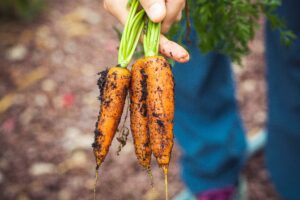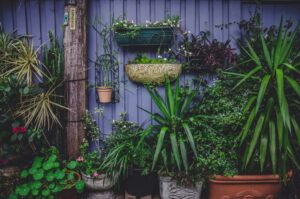Discovering the art of growing food that’s beautiful and functional can transform your backyard into a delightful oasis of taste and beauty. For homeowners, blending the visual appeal of traditional landscaping with the functionality of a kitchen garden offers the best of both worlds. This unique gardening approach combines aesthetic allure with the pleasure of fresh produce. Dive in to understand how to elevate your outdoor space and enjoy the dual benefits.
Interestingly, many food plants are stunningly beautiful. Their aesthetic appeal shines brightly through seasonal transitions, making growing food that’s beautiful and functional worthwhile year-round. From the vibrant hues of blossoming fruit trees to the deep greens of herbs, a dynamic visual journey awaits every gardener. While serving culinary needs, these plants also enhance the visual charm of gardens, offering homeowners a delightful fusion of utility and beauty.
Imagine the convenience and joy of plucking fresh basil leaves or picking ripe tomatoes just steps away from your kitchen. Edible landscapes provide a practical way to enjoy fresh produce, ensuring that you have the freshest ingredients for your meals. This direct access to organic, homegrown food saves trips to the grocery store and ensures a connection between you and your food. The experience of sowing, nurturing, and harvesting is deeply fulfilling, marrying functionality with personal satisfaction.
By growing your own produce, you’re actively making a sustainable and eco-friendly choice. Edible gardens substantially reduce the carbon footprint associated with transporting food from distant places. Plus, cultivating your own garden means fewer pesticides and chemicals, leading to a cleaner, more natural food source. Over time, as you enrich the soil and recycle organic waste, the garden becomes a sustainable loop, benefiting both the environment and your well-being, proving that local truly is better.

Growing food that’s beautiful and functional in your home is amazing for promoting sustainable life.
Mint, basil, and rosemary are culinary staples and eye-catching additions to any garden space. With their varied textures and colors, these herbs contribute to an enticing visual palette. As they grow and flourish, their aromatic presence also becomes a sensory delight, perfuming the air with natural fragrances. For those eager to delve deeper and learn about gardening tools, investing in specialised tools tailored for herb cultivation can make the gardening process even more rewarding.
Dwarf apple or cherry trees are a garden’s crowning jewels when growing food that’s beautiful and functional. With their spring blossoms and summer fruits, they offer year-round visual delight. Beyond trees, berry bushes, like blueberries and raspberries, are a multi-faceted treat, presenting delightful flowers, lush foliage, and juicy fruits in succession. The joy of witnessing a fruit tree’s journey from delicate blossoms to ripe, succulent fruits, ready for picking, is unmatched, making them an essential element in any edible landscape.
Leafy greens, such as kale and Swiss chard, offer a beautiful color contrast, transforming garden beds with vibrant hues. Ornamental peppers, in addition to their culinary uses, serve as garden showstoppers with their vivid colors and varied shapes. Picture a landscape where the fiery reds of chili peppers mingle with the deep purples of eggplants and the cheerful yellows of bell peppers. Each vegetable serves a culinary purpose and adds visual richness to the garden tapestry.

Growing vegetables is the most popular option with homeowners.
Strategically planning your garden space is a vital first step in edible landscaping. Start by dividing your garden into designated zones. This might encompass areas for herbs, vegetable patches, or a dedicated mini orchard. Integrate meandering pathways, using materials like gravel or stepping stones to create an inviting flow. Focal points, perhaps a central fruit tree or a water feature, can further elevate the overall design. Proper zoning ensures functionality, ease of maintenance, and aesthetic harmony.
Vertical gardening is a game-changer, especially for gardens with limited space. Utilising height not only maximises production but also adds a unique visual element. Implementing structures like trellises, vertical planters, or even repurposed ladders can transform the way plants are showcased. Cucumbers, peas, and certain varieties of tomatoes are perfect candidates for vertical growth. Climbing plants, as they ascend, create captivating green walls, offering both space efficiency and a dynamic visual appeal.

Vertical gardening is a great option for people with a smaller yard.
Incorporating edible borders and hedges adds structure and beauty to your garden. Plants like rosemary and lavender are aromatic choices that form dense, fragrant borders. Their perennial nature ensures year-round appeal. Berry bushes, such as currants and gooseberries, can be trained and pruned to create productive hedges. The dual advantage is clear: they delineate garden sections while offering delicious harvests. Furthermore, to protect and enhance these setups, it’s beneficial to include insect-repelling plants in your garden’s design.
Effective watering is fundamental to the success of an edible landscape. Each plant has its unique moisture requirements, so understanding these needs is essential. Systems like drip irrigation offer precise water delivery, ensuring plants get just what they need without wastage. Mulching around plants can retain moisture and reduce evaporation. Additionally, utilising rainwater collection methods, such as rain barrels, conserves resources and provides plants with chemical-free water, ensuring they thrive in optimal conditions.
Moving to a new home is an exciting yet challenging venture, and when you’ve invested time and love into your garden, the idea of leaving it behind can be disheartening. Fortunately, with careful planning, you can relocate your greenery with ease and move your garden to the new home. Begin by assessing which plants are portable and which might be better off staying. Potted plants, of course, are the easiest to transport. However, for those plants rooted in the ground, consider taking cuttings or dividing them to transplant in your new location. It’s vital to ensure they’re well-watered and protected during the move. Upon arrival at your new residence, prioritise re-establishing them in suitable spots and understanding the light and soil conditions.
The vitality of your edible landscape largely depends on the health of the soil. Rich, nourished earth is the bedrock of thriving plants. Periodic soil tests can help ascertain nutrient levels, enabling you to address deficiencies. Organic compost and other natural amendments can rejuvenate tired soil. A holistic approach would be to use a DIY fertiliser, ensuring that the plants receive tailored nutrition. Remember, the more you nurture the soil, the more bountiful your harvest will be.
In conclusion, cultivating an edible landscape is a transformative journey that marries aesthetic beauty with practical benefits. Through growing food that’s beautiful and functional, homeowners can create a garden oasis that nourishes the body, soul, and environment. It’s more than just gardening; it’s about crafting a sustainable, holistic space. By implementing these strategies, you’re building a legacy, a space that evolves, nourishes, and perpetually captivates.